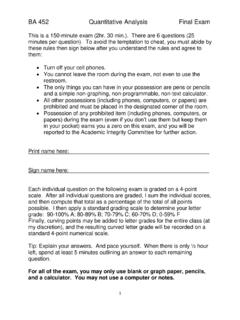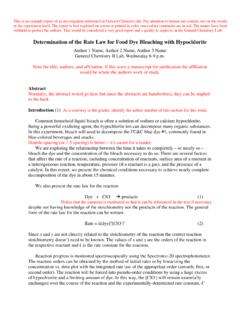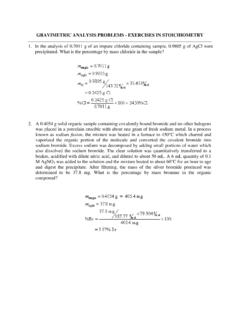Transcription of Practice Questions and Answers from Lesson I -7 ...
1 Practice Questions and Answers from Lesson I-7: Elasticity 1 Practice Questions and Answers from Lesson I-7 : Elasticity The following Questions Practice these skills: Use the midpoint method for calculating percent change. Compute price elasticity of demand. Identify elastic and inelastic demand according to the price elasticity of demand. For elastic demand, apply the negative relation between price and revenue. For inelastic demand, apply the positive relation between price and revenue. Remember demand is more elastic when there are more substitutes or closer substitutes. Compute the price elasticity of supply. Compute cross-price elasticities of demand. Relate cross-price elasticities of demand to gross substitutes and gross complements.
2 Identify elastic and inelastic portions of a linear demand curve. Compute income elasticity of demand. Question: , the online bookseller, wants to increase its total revenue. One strategy is to offer a 10% discount on every book it sells. knows that its customers can be divided into two distinct groups according to their likely responses to the discount. The accompanying table shows how the two groups respond to the discount. Group A (sales per week) Group B (sales per week) Volume of sales before the 10% discount million million Volume of sales after the 10% discount million million a. Using the midpoint method, calculate the price elasticities of demand for group A and group B.
3 B. Explain how the discount will affect total revenue from each group. c. Suppose knows which group each customer belongs to when he logs on and can choose whether or not to offer the 10% discount. If wants to increase its total revenue, should discounts be offered to group A or to group B, to neither group, or to both groups? Answer to Question: a. Using the midpoint method, the percent change in the quantity demanded by group A is million - million million x 100 = x 100 = ( million + million)/2 million and since the change in price is 10%, the price elasticity of demand for group A is Practice Questions and Answers from Lesson I-7: Elasticity 2 = Using the midpoint method, the percent change in the quantity demanded by group B is 1.
4 7 million - million million x 100 = x 100 = ( million + 1. 7 million)/2 million and since the change in price is 10%, the price elasticity of demand for group B is = b. For group A, since the price elasticity of demand is (demand is inelastic), total revenue will decrease as a result of the discount. For group B, since the price elasticity of demand is (demand is elastic), total revenue will increase as a result of the discount. c. If wants to increase total revenue, it should definitely not offer the discount to group A and it should definitely offer the discount to group B. Question: Do you think the price elasticity of demand for Ford sport-utility vehicles (SUVs) will increase, decrease, or remain the same when each of the following events occurs?
5 Explain your answer. a. Other car manufacturers, such as General Motors, decide to make and sell SUVs. b. SUVs produced in foreign countries are banned from the American market. c. Due to ad campaigns, Americans believe that SUVs are much safer than ordinary passenger cars. d. The time period over which you measure the elasticity lengthens. During that longer time, new models such as four-wheel-drive cargo vans appear. Answer to Question: a. The price elasticity of demand for Ford SUVs will increase because more substitutes are available. b. The price elasticity of demand for Ford SUVs will decrease because fewer substitutes are available. c. The price elasticity of demand for Ford SUVs will decrease because other cars are viewed as less of a substitute.
6 D. The price elasticity of demand for Ford SUVs will increase over time because more substitutes (such as four-wheel-drive cargo vans) become available. Question: The accompanying table gives part of the supply schedule for personal computers in the United States. Price of computer Quantity of computers supplied $1,100 12,000 $900 8,000 a. Calculate the price elasticity of supply when the price increases from $900 to $1,100 using the midpoint method. Practice Questions and Answers from Lesson I-7: Elasticity 3 b. Suppose firms produce 1,000 more computers at any given price due to improved technology. As price increases from $900 to $1,100, is the price elasticity of supply now greater than, less than, or the same as it was in part a?
7 C. Suppose a longer time period under consideration means that the quantity supplied at any given price is 20% higher than the figures given in the table. As price increases from $900 to $1,100, is the price elasticity of supply now greater than, less than, or the same as it was in part a? Answer to Question: a. Using the midpoint method, the percent change in the quantity supplied is 12,000 8,000 4,000 x 100 = x 100 = 40% (12,000 + 8,000)/2 10,000 and the percent change in the price is $1,100 - $900 $200 x 100 = x 100 = 20% ($1,100 + $900)/2 $1,000 The price elasticity of supply is therefore 40%/20% = 2 b.
8 The elasticity estimate would be lower. A price change from $900 to $1,100 is a 20% price change, just as calculated in part a. Previously, when the quantity supplied changed from 8,000 to 12,000, that was a 40% change in the quantity supplied. Now that the quantity supplied at each price is higher by 1,000, the same price change would imply a change in the quantity supplied from 9,000 to 13,000, which is a 36% change using the midpoint method. The new price elasticity of supply is 36%/20% = , which is lower than in part a. c. The elasticity estimate would be unchanged. The price increase from $900 to $1,100 is a 20% increase, just as calculated in part a. But now that all quantities are 20% higher, the quantity supplied increases from 9,600 to 14,400.
9 Using the midpoint method, this is an increase of 14,400 9,600 4,800 x 100 = x 100 = 40% (14,400 + 9,600)/2 12,000 so that the price elasticity of supply is 40%/20% = 2 Therefore the price elasticity of supply is the same as in part a. Question: The accompanying table lists the cross-price elasticities of demand for several goods, where the percent quantity change is measured for the first good of the pair, and the percent price Practice Questions and Answers from Lesson I-7: Elasticity 4 change is measured for the second good. Good Cross-price elasticities of demand Air-conditioning units and kilowatts of electricity Coke and Pepsi + High-fuel-consuming sport-utility vehicles (SUVs) and gasoline McDonald s burgers and Burger King burgers + Butter and margarine + a.
10 Explain the sign of each of the cross-price elasticities. What does it imply about the relationship between the two goods in question? b. Compare the absolute values of the cross-price elasticities and explain their magnitudes. For example, why is the cross-price elasticity of McDonald s burgers and Burger King burgers less than the cross-price elasticity of butter and margarine? c. Use the information in the table to calculate how a 5% increase in the price of Pepsi affects the quantity of Coke demanded. d. Use the information in the table to calculate how a 10% decrease in the price of gasoline affects the quantity of SUVs demanded. Answer to Question: a. A negative cross-price elasticity of demand implies that the two goods are gross complements.





